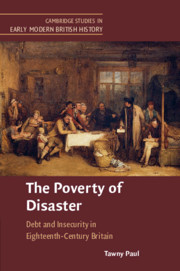Book contents
- The Poverty of Disaster
- Cambridge Studies in Early Modern British History
- The Poverty of Disaster
- Copyright page
- Dedication
- Contents
- Figures
- Tables
- Acknowledgements
- Introduction
- Part I Structures of Insecurity
- Part II The Insecure Self
- Part III The Debtor’s Body
- Chapter 6 Punishing the Body
- Chapter 7 The Worth of Bodies
- Conclusion
- Bibliography
- Index
Conclusion
from Part III - The Debtor’s Body
Published online by Cambridge University Press: 27 September 2019
- The Poverty of Disaster
- Cambridge Studies in Early Modern British History
- The Poverty of Disaster
- Copyright page
- Dedication
- Contents
- Figures
- Tables
- Acknowledgements
- Introduction
- Part I Structures of Insecurity
- Part II The Insecure Self
- Part III The Debtor’s Body
- Chapter 6 Punishing the Body
- Chapter 7 The Worth of Bodies
- Conclusion
- Bibliography
- Index
Summary
This concluding chapter considers the implications of insecurity for narratives of economic success and proletarianisation in eighteenth-century Britain. It argues that economic growth generated social inequality and was compatible with failure. Risk was built into the capitalist model. Credit was a tool that allowed for innovation and entrepreneurship, but it also brought people down. The assumption that periods of economic growth bring shared prosperity therefore requires revision. Furthermore, there was a much broader segment of society who were precarious in the eighteenth century than the proletariat, but they were precarious in different ways. Middling poverty was not built around their relationship to the means of production, their relationship to land tenure or their need to sell their labour. Instead, their insecurities were a result of their relationship to debt. A new vision of class formation is therefore necessary, which recognises these broader forms of insecurity.
- Type
- Chapter
- Information
- The Poverty of DisasterDebt and Insecurity in Eighteenth-Century Britain, pp. 236 - 247Publisher: Cambridge University PressPrint publication year: 2019

